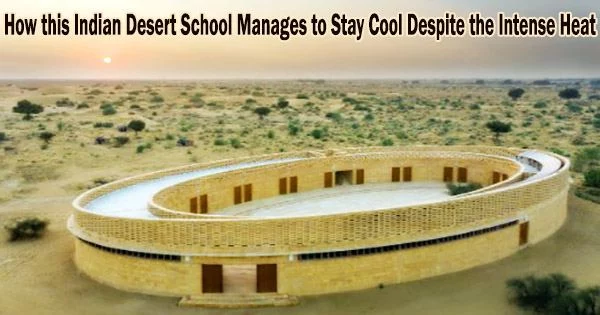At the height of summer, temperatures in Jaisalmer, a desert town in northern India, can reach about 120 degrees Fahrenheit (49 degrees Celsius). This town is sometimes referred to as “The Golden City” because of its extensive collection of yellow sandstone buildings.
With her work on the Rajkumari Ratnavati Girls’ School, New York architect Diana Kellogg continued a tradition where structures have traditionally been made to withstand the heat.
The project was commissioned by CITTA, a US non-profit organization that offers economic and educational support to women in rural and underserved communities, with the goal of empowering women and girls through education in a region of India where the female literacy rate is the lowest. It is the initial phase of a three-part architectural project that also consists of a women’s cooperative center and an exhibition area.
According to Kellogg, the eco-friendly sandstone school debuted in November 2021 and has 120 girls enrolled in its program. Architectural Digest India named it the 2020 “Building of the Year.”
Natural cooling
In the midst of the Thar desert, where drought spells are becoming longer and more extreme due to climate change, designing a suitable learning area might be difficult. After visiting Jaisalmer in 2014, Kellogg, who often designs high-end residential projects, was inspired to create the structure. He wanted it to combine traditional Jaisalmer architectural elements with contemporary elements to represent the tenacity and hope of the desert.
“There are methods to cool spaces that have been used for centuries. What I did is I put them together in a combination that worked,” Kellogg said, adding that indoor temperatures at the school are approximately 20-30 degrees Fahrenheit lower than the outdoors.
She chose to utilize locally available sandstone for the building because it is a climate-resistant material that has been used for structures in the area for a long time, including the Jaisalmer Fort, which is a section of the city that houses a quarter of its inhabitants and is a UNESCO World Heritage site.
“It’s so abundant in this area. It’s very reasonable (in price) and the extremely talented stonemasons are just magicians with the stone,” Kellogg said. “It actually keeps the heat out and also keeps the coolness out at night.”
Lining the interior walls with lime plaster, a porous and naturally cooling substance that aids in releasing any trapped moisture brought on by humidity, is one of the ancient techniques Kellogg included into the design.
She also added a jali wall, a sandstone grid that allows wind to accelerate in a process known as the venturi effect, cooling the courtyard area while also offering shelter from the sun. She was inspired by other buildings in the area. In classrooms, high ceilings and windows dissipate rising heat, and a solar panel canopy offers shade and power.
The building’s circular shape, which also corresponds to femininity and the project’s ethos and is tilted toward the direction of the wind, was chosen for its capacity to hold and circulate cold air. Kellogg calls it “a big, tight hug.”
Comfort in sustainability
There are several ways that buildings and schools in hot, dry desert climates can stay cool, even in extreme heat. Here are a few examples:
- Shade: Providing shade over windows, walls, and other exposed surfaces can help block the sun’s rays and reduce the amount of heat that enters the building.
- Insulation: Proper insulation can help keep heat out and cool air in, which can help keep a building cool in extreme heat.
- Ventilation: Proper ventilation can help circulate cool air throughout a building and remove hot air, which can help keep the building cool.
- Evaporative cooling: This involves using water to cool the air through evaporation. An evaporative cooler, also known as a “swamp cooler,” works by blowing hot, dry air over a wet pad, which cools the air through evaporation.
- Reflective materials: Using reflective materials on roofs, walls, and other exposed surfaces can help reflect the sun’s rays and reduce the amount of heat that is absorbed by the building.
- Trees and vegetation: Planting trees and other vegetation around a building can provide shade and help cool the air through evaporation.
Although many of the cooling methods utilized at the school might theoretically be used elsewhere, Kellogg acknowledges that their viability and efficacy would vary from location to location. The materials found and used in Jaisalmer, for instance, might regulate temperatures differently than certain wind directions and other sandstones.
Since it is uncommon in the area and has a negative influence on the environment, air conditioning is not utilized anyplace in the building. She thinks that by using more conventional and natural cooling methods that the children are accustomed to, they will feel more at ease and confident as a result of their surroundings.
“I’ve seen it myself over the last three, four months,” she said. “The change in the girls, from being quite shy to being these bright lights that are devouring whatever kind of information you put in front of them.”
















